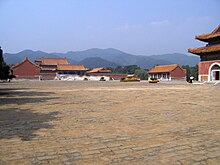Yuling mausoleum
The Yu Ling ( Chinese 裕 陵 , Pinyin yù líng , "burial mound of abundance") is a Chinese mausoleum , built for the Chinese emperor Qianlong from the Qing dynasty . It is located in the East Qing Tombs in Zunhua County, 125 km east of Beijing .
The structure of the Yuling follows the model of the imperial tombs from the Ming dynasty , the so-called Ming tombs . First you come across a marble gate of honor . Next up is the Great Red Gate, in which a turtle stele provides information about the emperor's merits. Then you enter a soul path, which is lined with figures of officials and animals. These are supposed to symbolize humility towards the emperor. The dragon phoenix gate and the seven-arch bridge made of white marble lead to the forecourt of the 50 hectare Yuling burial precinct. Inside there is a large sacrificial hall with the associated soul tower, behind it the actual tomb tumulus under which the underground palace for the dead emperor is located.
The underground palace is built entirely of stone in the traditional style and is decorated over and over with ornaments and Tibetan characters. The palace is 54 m long and has a total area of 372 m². The burial chamber consists of three rooms, which were closed with stone doors. The shape of the entire underground palace results in the character for Wang王 (ruler).
Emperor Qianlong cost the plant an immense sum of 1.8 million tael . From 1743 to 1752 he created one of the largest imperial tombs in China , even the largest of his entire dynasty. The emperor is buried here with the empresses Xiao Xian and Xiao Yi Chun , as well as the concubines Chun Hui, Zhe Min and Shu. They were all buried here in 1799 at a lavish and lavish ceremony in the presence of the heir to the throne Jiaqing , the imperial clan and the ministers with precious gifts.
In 1928 , Kuomintang troops ransacked the grave. Under the orders of Brigadier General Han Dabao, they blew up the access wall to the underground palace, pushed open the gate with the statues of bodhisattwas , removed the second, third and fourth stone gates and entered the back chamber of the tomb. They took away the rich treasures of the grave, even took the dead out of their coffins and plundered them completely. They even took the robes made of silk and gold cloth with them. The loss of treasure that this desecration caused was immeasurable. After this looting, almost nothing was left of the grave goods. Fortunately, however, the architecture of the facility remained undamaged. Violent protests by the Chinese population and especially by the abdicated Emperor Puyi near Chiang Kai-shek , to punish those responsible, were ignored.
Today, along with the tombs of the Ming Emperor Wanli and the Qing Emperor Guangxu , the Yuling is the only imperial tomb that has ever been opened and is freely accessible to the public.
literature
- Boyang Wang: Imperial Mausoleums and Tombs (= Ancient Chinese Architecture ). Springer, Vienna et al. 1998, ISBN 3-211-82991-1 .
Coordinates: 40 ° 11 '8.82 " N , 117 ° 38' 48.92" O


